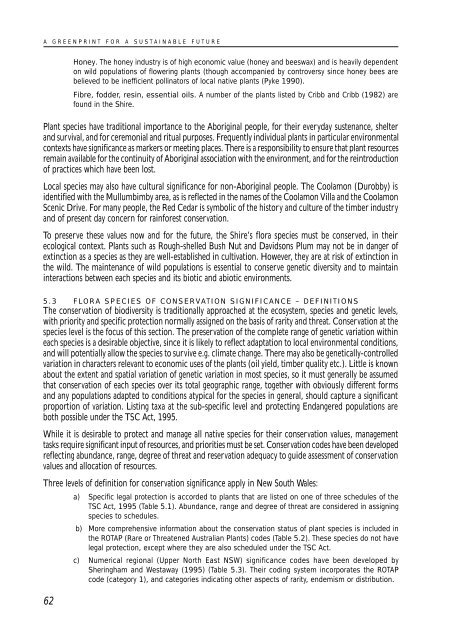Byron Flora and Fauna Study 1999 - Byron Shire Council
Byron Flora and Fauna Study 1999 - Byron Shire Council
Byron Flora and Fauna Study 1999 - Byron Shire Council
You also want an ePaper? Increase the reach of your titles
YUMPU automatically turns print PDFs into web optimized ePapers that Google loves.
A GREENPRINT FOR A SUSTAINABLE FUTURE<br />
62<br />
Honey. The honey industry is of high economic value (honey <strong>and</strong> beeswax) <strong>and</strong> is heavily dependent<br />
on wild populations of flowering plants (though accompanied by controversy since honey bees are<br />
believed to be inefficient pollinators of local native plants (Pyke 1990).<br />
Fibre, fodder, resin, essential oils. A number of the plants listed by Cribb <strong>and</strong> Cribb (1982) are<br />
found in the <strong>Shire</strong>.<br />
Plant species have traditional importance to the Aboriginal people, for their everyday sustenance, shelter<br />
<strong>and</strong> survival, <strong>and</strong> for ceremonial <strong>and</strong> ritual purposes. Frequently individual plants in particular environmental<br />
contexts have significance as markers or meeting places. There is a responsibility to ensure that plant resources<br />
remain available for the continuity of Aboriginal association with the environment, <strong>and</strong> for the reintroduction<br />
of practices which have been lost.<br />
Local species may also have cultural significance for non-Aboriginal people. The Coolamon (Durobby) is<br />
identified with the Mullumbimby area, as is reflected in the names of the Coolamon Villa <strong>and</strong> the Coolamon<br />
Scenic Drive. For many people, the Red Cedar is symbolic of the history <strong>and</strong> culture of the timber industry<br />
<strong>and</strong> of present day concern for rainforest conservation.<br />
To preserve these values now <strong>and</strong> for the future, the <strong>Shire</strong>’s flora species must be conserved, in their<br />
ecological context. Plants such as Rough-shelled Bush Nut <strong>and</strong> Davidsons Plum may not be in danger of<br />
extinction as a species as they are well-established in cultivation. However, they are at risk of extinction in<br />
the wild. The maintenance of wild populations is essential to conserve genetic diversity <strong>and</strong> to maintain<br />
interactions between each species <strong>and</strong> its biotic <strong>and</strong> abiotic environments.<br />
5.3 FLORA SPECIES OF CONSERVATION SIGNIFICANCE – DEFINITIONS<br />
The conservation of biodiversity is traditionally approached at the ecosystem, species <strong>and</strong> genetic levels,<br />
with priority <strong>and</strong> specific protection normally assigned on the basis of rarity <strong>and</strong> threat. Conservation at the<br />
species level is the focus of this section. The preservation of the complete range of genetic variation within<br />
each species is a desirable objective, since it is likely to reflect adaptation to local environmental conditions,<br />
<strong>and</strong> will potentially allow the species to survive e.g. climate change. There may also be genetically-controlled<br />
variation in characters relevant to economic uses of the plants (oil yield, timber quality etc.). Little is known<br />
about the extent <strong>and</strong> spatial variation of genetic variation in most species, so it must generally be assumed<br />
that conservation of each species over its total geographic range, together with obviously different forms<br />
<strong>and</strong> any populations adapted to conditions atypical for the species in general, should capture a significant<br />
proportion of variation. Listing taxa at the sub-specific level <strong>and</strong> protecting Endangered populations are<br />
both possible under the TSC Act, 1995.<br />
While it is desirable to protect <strong>and</strong> manage all native species for their conservation values, management<br />
tasks require significant input of resources, <strong>and</strong> priorities must be set. Conservation codes have been developed<br />
reflecting abundance, range, degree of threat <strong>and</strong> reservation adequacy to guide assessment of conservation<br />
values <strong>and</strong> allocation of resources.<br />
Three levels of definition for conservation significance apply in New South Wales:<br />
a) Specific legal protection is accorded to plants that are listed on one of three schedules of the<br />
TSC Act, 1995 (Table 5.1). Abundance, range <strong>and</strong> degree of threat are considered in assigning<br />
species to schedules.<br />
b) More comprehensive information about the conservation status of plant species is included in<br />
the ROTAP (Rare or Threatened Australian Plants) codes (Table 5.2). These species do not have<br />
legal protection, except where they are also scheduled under the TSC Act.<br />
c) Numerical regional (Upper North East NSW) significance codes have been developed by<br />
Sheringham <strong>and</strong> Westaway (1995) (Table 5.3). Their coding system incorporates the ROTAP<br />
code (category 1), <strong>and</strong> categories indicating other aspects of rarity, endemism or distribution.

















